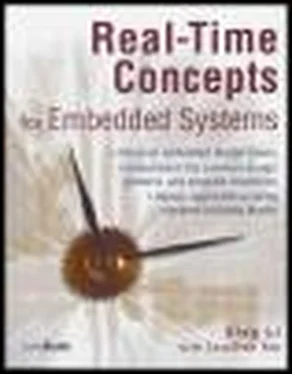What differentiates hard real-time systems and soft real-time systems are the degree of tolerance of missed deadlines, usefulness of computed results after missed deadlines, and severity of the penalty incurred for failing to meet deadlines.
For hard real-time systems, the level of tolerance for a missed deadline is extremely small or zero tolerance. The computed results after the missed deadline are likely useless for many of these systems. The penalty incurred for a missed deadline is catastrophe. For soft real-time systems, however, the level of tolerance is non-zero. The computed results after the missed deadline have a rate of depreciation. The usefulness of the results does not reach zero immediately passing the deadline, as in the case of many hard real-time systems. The physical impact of a missed deadline is non-catastrophic.
A hard real-time system is a real-time system that must meet its deadlines with a near-zero degree of flexibility. The deadlines must be met, or catastrophes occur. The cost of such catastrophe is extremely high and can involve human lives. The computation results obtained after the deadline have either a zero-level of usefulness or have a high rate of depreciation as time moves further from the missed deadline before the system produces a response.
A soft real-time system is a real-time system that must meet its deadlines but with a degree of flexibility. The deadlines can contain varying levels of tolerance, average timing deadlines, and even statistical distribution of response times with different degrees of acceptability. In a soft real-time system, a missed deadline does not result in system failure, but costs can rise in proportion to the delay, depending on the application.
Penalty is an important aspect of hard real-time systems for several reasons.
· What is meant by 'must meet the deadline'?
· It means something catastrophic occurs if the deadline is not met. It is the penalty that sets the requirement.
· Missing the deadline means a system failure, and no recovery is possible other than a reset, so the deadline must be met. Is this a hard real-time system?
That depends. If a system failure means the system must be reset but no cost is associated with the failure, the deadline is not a hard deadline, and the system is not a hard real-time system. On the other hand, if a cost is associated, either in human lives or financial penalty such as a $50 million lawsuit, the deadline is a hard deadline, and it is a hard real-time system. It is the penalty that makes this determination.
· What defines the deadline for a hard real-time system?
· It is the penalty. For a hard real-time system, the deadline is a deterministic value, and, for a soft real-time system, the value can be estimation.
One thing worth noting is that the length of the deadline does not make a real-time system hard or soft, but it is the requirement for meeting it within that time.
The weapons defense and the missile guidance systems are hard real-time systems. Using the missile guidance system for an example, if the navigation system cannot compute the new coordinates in response to approaching mountain terrain before or at the deadline, not enough distance is left for the missile to change altitude. This system has zero tolerance for a missed deadline. The new coordinates obtained after the deadline are no longer useful because at subsonic speed the distance is too short for the altitude control system to navigate the missile into the new flight path in time. The penalty is a catastrophic event in which the missile collides with the mountain. Similarly, the weapons defense system is also a zero-tolerance system. The missed deadline results in the missile sinking the destroyer, and human lives potentially being lost. Again, the penalty incurred is catastrophic.
On the other hand, the DVD player is a soft real-time system. The DVD player decodes the video and the audio streams while responding to user commands in real time. The user might send a series of commands to the DVD player rapidly causing the decoder to miss its deadline or deadlines. The result or penalty is momentary but visible video distortion or audible audio distortion. The DVD player has a high level of tolerance because it continues to function. The decoded data obtained after the deadline is still useful.
Timing correctness is critical to most hard real-time systems. Therefore, hard real-time systems make every effort possible in predicting if a pending deadline might be missed. Returning to the weapons defense system, let us discuss how a hard real-time system takes corrective actions when it anticipates a deadline might be missed. In the weapons defense system example, the C&D system calculates a firing box around the projected missile flight path. The missile must be destroyed a certain distance away from the ship or the shrapnel can still cause damage. If the C&D system anticipates a missed deadline (for example, if by the time the precise firing coordinates are computed, the missile would have flown past the safe zone), the C&D system must take corrective action immediately. The C&D system enlarges the firing box and computes imprecise firing coordinates by methods of estimation instead of computing for precise values. The C&D system then activates additional weapons firing systems to compensate for this imprecision. The result is that additional guns are brought online to cover the larger firing box. The idea is that it is better to waste bullets than sink a destroyer.
This example shows why sometimes functional correctness might be sacrificed for timing correctness for many real-time systems.
Because one or a few missed deadlines do not have a detrimental impact on the operations of soft real-time systems, a soft real-time system might not need to predict if a pending deadline might be missed. Instead, the soft real-time system can begin a recovery process after a missed deadline is detected.
For example, using the real-time DVD player, after a missed deadline is detected, the decoders in the DVD player use the computed results obtained after the deadline and use the data to make a decision on what future video frames and audio data must be discarded to re-synchronize the two streams. In other words, the decoders find ways to catch up.
So far, we have focused on meeting the deadline or the finish time of some work or job, e.g., a computation. At times, meeting the start time of the job is just as important. The lack of required resources for the job, such as CPU or memory, can prevent a job from starting and can lead to missing the job completion deadline. Ultimately this problem becomes a resource-scheduling problem. The scheduling algorithms of a real-time system must schedule system resources so that jobs created in response to both periodic and aperiodic events can obtain the resources at the appropriate time. This process affords each job the ability to meet its specific timing constraints. This topic is addressed in detail in Chapter 14.
1.3 The Future of Embedded Systems
Until the early 1990s, embedded systems were generally simple, autonomous devices with long product lifecycles. In recent years, however, the embedded industry has experienced dramatic transformation, as reported by the Gartner Group, an independent research and advisory firm, as well as by other sources:
· Product market windows now dictate feverish six- to nine-month turnaround cycles.
· Globalization is redefining market opportunities and expanding application space.
· Connectivity is now a requirement rather than a bonus in both wired and emerging wireless technologies.
· Electronics-based products are more complex.
· Interconnecting embedded systems are yielding new applications that are dependent on networking infrastructures.
Читать дальше












